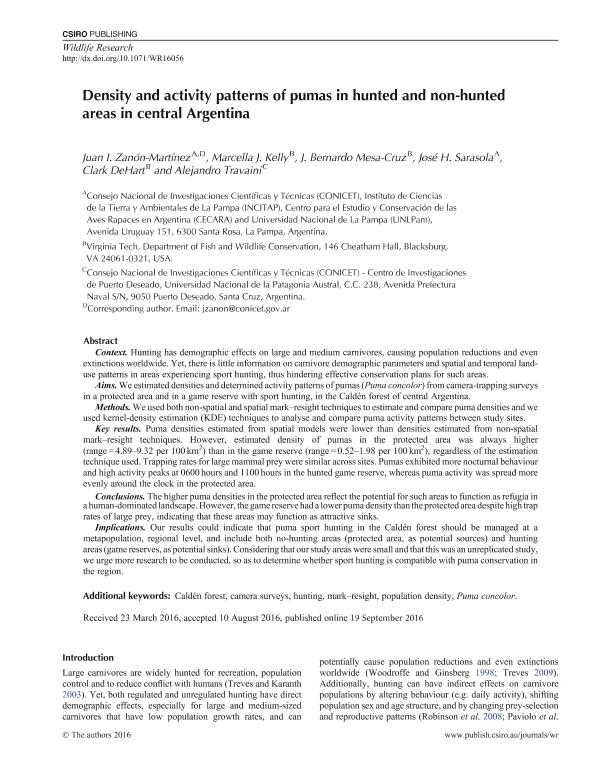Mostrar el registro sencillo del ítem
dc.contributor.author
Zanón Martínez, Juan Ignacio

dc.contributor.author
Kelly, Marcella J.
dc.contributor.author
Mesa Cruz, J. Bernardo
dc.contributor.author
Sarasola, José Hernán

dc.contributor.author
DeHart, Clark
dc.contributor.author
Travaini, Alejandro

dc.date.available
2018-05-04T18:52:29Z
dc.date.issued
2016-09
dc.identifier.citation
Zanón Martínez, Juan Ignacio; Kelly, Marcella J.; Mesa Cruz, J. Bernardo; Sarasola, José Hernán; DeHart, Clark; et al.; Density and activity patterns of pumas in hunted and non-hunted areas in central Argentina; Csiro Publishing; Wildlife Research; 43; 6; 9-2016; 449-460
dc.identifier.issn
1035-3712
dc.identifier.uri
http://hdl.handle.net/11336/44202
dc.description.abstract
Context. Hunting has demographic effects on large and medium carnivores, causing population reductions and evenextinctions worldwide. Yet, there is little information on carnivore demographic parameters and spatial and temporal landusepatterns in areas experiencing sport hunting, thus hindering effective conservation plans for such areas.5 Aims. We estimated densities and determined activity patterns of pumas (Puma concolor) from camera-trapping surveysin a protected area and in a game reserve with sport hunting, in the Caldén forest of central Argentina.Methods. We used both non-spatial and spatial mark?resight techniques to estimate and compare puma densities and weused kernel-density estimation (KDE) techniques to analyse and compare puma-activity patterns between study sites.Key results. Puma densities estimated from spatial models were lower than densities estimated from non-spatial10 mark?resight techniques. However, estimated density of pumas in the protected area was always higher(range = 4.9?9.32 per 100 km2) than in the game reserve (range = 0.52?1.98 per 100 km2), regardless of the estimationtechnique used. Trapping rates for large mammal prey were similar across sites. Pumas exhibited more nocturnal behaviourand high activity peaks at 0600 hours and 1100 hours in the hunted game reserve, whereas puma activity was spread moreevenly around the clock in the protected area.15 Conclusions. The higher puma densities in the protected area reflect the potential for such areas to function as refugia ina human-dominated landscape. However, the game reserve had a lower puma density despite high trap rates of largeprey, indicating that these areas may function as attractive sinks.Implications. Our results could indicate that puma sport hunting in the Caldén forest should be managed at ametapopulation, regional level, and include both no-hunting areas (protected area, as potential sources) and hunting20 areas (game reserves, as potential sinks). Considering that our study areas were small and that this was an unreplicated study,we urge more research to be conducted, so as to determine whether sport hunting is compatible with puma conservation inthe region.
dc.format
application/pdf
dc.language.iso
eng
dc.publisher
Csiro Publishing

dc.rights
info:eu-repo/semantics/openAccess
dc.rights.uri
https://creativecommons.org/licenses/by-nc-sa/2.5/ar/
dc.subject
Caldén Forest
dc.subject
Camera Surveys
dc.subject
Population Density
dc.subject
Puma Concolor
dc.subject.classification
Otras Ciencias Biológicas

dc.subject.classification
Ciencias Biológicas

dc.subject.classification
CIENCIAS NATURALES Y EXACTAS

dc.title
Density and activity patterns of pumas in hunted and non-hunted areas in central Argentina
dc.type
info:eu-repo/semantics/article
dc.type
info:ar-repo/semantics/artículo
dc.type
info:eu-repo/semantics/publishedVersion
dc.date.updated
2018-05-04T14:58:33Z
dc.journal.volume
43
dc.journal.number
6
dc.journal.pagination
449-460
dc.journal.pais
Australia

dc.journal.ciudad
Collingwood
dc.description.fil
Fil: Zanón Martínez, Juan Ignacio. Consejo Nacional de Investigaciones Científicas y Técnicas. Instituto de Ciencias de la Tierra y Ambientales de La Pampa. Universidad Nacional de La Pampa. Facultad de Ciencias Exactas y Naturales. Instituto de Ciencias de la Tierra y Ambientales de La Pampa; Argentina
dc.description.fil
Fil: Kelly, Marcella J.. Virginia Tech University; Estados Unidos
dc.description.fil
Fil: Mesa Cruz, J. Bernardo. Virginia Tech University; Estados Unidos
dc.description.fil
Fil: Sarasola, José Hernán. Consejo Nacional de Investigaciones Científicas y Técnicas. Instituto de Ciencias de la Tierra y Ambientales de La Pampa. Universidad Nacional de La Pampa. Facultad de Ciencias Exactas y Naturales. Instituto de Ciencias de la Tierra y Ambientales de La Pampa; Argentina
dc.description.fil
Fil: DeHart, Clark. Virginia Tech University; Estados Unidos
dc.description.fil
Fil: Travaini, Alejandro. Consejo Nacional de Investigaciones Científicas y Técnicas; Argentina. Universidad Nacional de la Patagonia Austral. Unidad Académica Caleta Olivia. Centro de Investigaciones Puerto Deseado; Argentina
dc.journal.title
Wildlife Research

dc.relation.alternativeid
info:eu-repo/semantics/altIdentifier/doi/http://dx.doi.org/10.1071/WR16056
dc.relation.alternativeid
info:eu-repo/semantics/altIdentifier/url/http://www.publish.csiro.au/wr/WR16056
Archivos asociados
